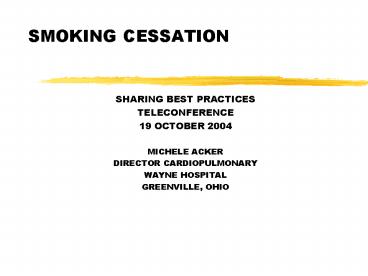SMOKING CESSATION PowerPoint PPT Presentation
1 / 7
Title: SMOKING CESSATION
1
SMOKING CESSATION
- SHARING BEST PRACTICES
- TELECONFERENCE
- 19 OCTOBER 2004
- MICHELE ACKER
- DIRECTOR CARDIOPULMONARY
- WAYNE HOSPITAL
- GREENVILLE, OHIO
2
HISTORY OF WAYNE HOSPITAL SMOKING CESSATION
EDUCATIONAL PROGRAM
- July 2001 - Wayne Hospital Smoke Stoppers Smoking
Cessation Program established . - July 2002- Inpatient smoking cessation education
being tracked - Respiratory therapy tasked with distributing
pamphlets to patients who had a smoking history
and were on respiratory treatments or oxygen. - Nursing tasked with notifying respiratory if a
patient was not on respiratory treatments. - March 2003- Computerized charting began at Wayne
Hospital - Education section noted smoking cessation
education given on respiratory treatment flow
sheet - Tracking of smoking cessation education performed
by nursing staff and performance improvement
coordinator. - June 2003 -Performance improvement coordinator
presented Keys to Success w/ Smoking Cessation
Counseling to inpatient care committee- Ohio
Kepro Article. - July 2003- Work began for implementation of
clinical pathways for CHF and Community acquired
pneumonia- Trigger placed on pathway to call
cardiopulmonary for smoking cessation education
if patient had a smoking history. - September 2003-
- Respiratory therapy began monitoring smoking
cessation education documentation on respiratory
patients. - Clinical pathways approved for use
- June 23, 2004-Respiratory Therapists attended the
Ohio Kepro Smoking Cessation Teleconference - July 2004-Respiratory began working on ad hoc
report to identify inpatients who smoked - September 2004- daily ad hoc report generated
from computer system identifying all patients in
hospital who smoke - October 2004- Use of clinical pathways made
mandatory by medical staff.
3
DISCIPLINES INVOLVED IN IDENTIFYING AND EDUCATING
PATIENTS WHO SMOKE
- Registration supplies the information of patient
status, i.e.., inpatient, outpatient, or
emergency department, when the patient is
registered. - Nursing identifies the patient as a smoker or
nonsmoker with the initial patient assessment. - Respiratory identifies the patient as a smoker or
nonsmoker with initial assessment on patients
receiving respiratory treatments or oxygen. - Cardiopulmonary clerk prints out daily ad hoc
report with a list on patients who smoke. - Respiratory therapy presents the patient with a
pamphlet from the American Cancer Society along
with an insert describing the outpatient smoking
cessation program and number to call to enroll. - The telephone number for the Ohio Tobacco use
prevention and control foundation quit line is
printed on the insert. - The dietician presents the class on healthy
nutrition during the outpatient program. - A section for physician smoking cessation
education is present on the clinical pathway
discharge orders.
4
TRENDING DATA
- CHF 3RD QUARTER 2002- AVERAGE 90
- 3RD QUARTER 2003-CAP 25, AMI 33
- 3RD QUARTER 2003 RESPIRATORY EDUCATION AVERAGE
-65 - 4TH QUARTER 2003-AMI-NO APPLICABLE PATIENTS, CAP
38, CHF-75 - 1ST QUARTER 2004
- AMI- NO APPLICABLE PATIENTS, CAP 44, TOTAL 9
PATIENTS, - CHF, 1 PATIENT WAS NOT COUNSELED.
- RESPIRATORY STATISTICS FOR 2004
- AVERAGE 43 FROM JANUARY-AUGUST
- SEPTEMBER -AD HOC REPORT-100
5
IMPROVEMENTS ALONG THE WAY
- The initial process was too loosely defined.
Nursing was supposed to hand out the pamphlets on
patients not receiving respiratory treatments.
Respiratory was supposed to hand out pamphlets to
respiratory patients. - Although the clinical pathways were implemented
in September of 2003, many physicians did not
utilize them. The trigger for education was not
helpful because they were not being used.
Clinical pathways have now been approved to be
mandatory on acute myocardial infarction
patients, community acquired pneumonia, and CHF. - Respiratory therapists were not always notified
of smoking patients. - Initial assessments and education by respiratory
was sporadic. - Due to workload
- agency and resource use
- lack of buy in by the therapists
- After the teleconference from Ohio Kepro in June
2003, more therapists bought into the importance
of their role in the education process. - The addition of the daily ad hoc report
identified all patients who smoke. - Pamphlets have been placed on all the nursing
units as well as in the department where they are
in sight and easily accessible.
6
EXPANSION OF THE PROGRAM
- With the implementation of the daily ad hoc
report, we have identified a large population
that was being missed before due to the
identification process---- New mothers - We have also provided the Pre admission testing
nurse with pamphlets to distribute to pre
surgical patients. - Our goal at Wayne is to continue to reach out
into the community to educate the public on
smoking cessation and prevention. We have been
doing this by attending various health fairs in
the community and presenting information to the
community. - In April the plan is to team up with the Miami
Valley Youth Health Improvement Coalition group
from the High School to present an interactive
booth on smoking prevention for the 5th grade
health fair at our local fairgrounds. This
should expose approximately 1000 5th graders to
the dangers of smoking.
7
CONCLUSION
- Having been a smoking cessation facilitator for
3 years and having seen the low statistics of
attendance and relapse of people who quit
smoking, I sometimes wonder if it is worth it. - Then in the next class we get a couple who have
smoked for 60 years and they quit together. .. Or
the man who was going to have to go on disability
but was able to continue working after quitting.
Then I know, it is all worth it. - We have to do it.. ONE PATIENT AT A TIME
- THANK YOU
- FOR QUESTIONS OR COMMENTS , PLEASE FEEL FREE TO
CALL - SHELLY ACKER AT 937-547-5943
- OR E-MAIL AT michele.acker_at_waynehospital.com

